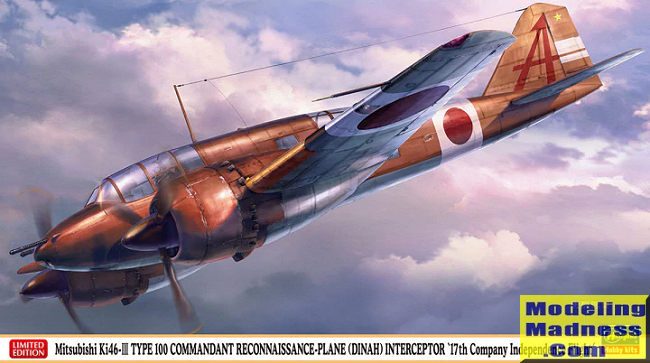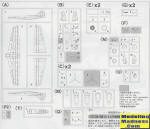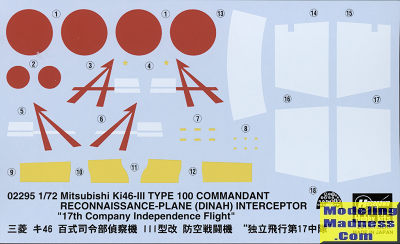
Hasegawa 1/72 Ki-46-III type 100 Dinah '17th Company Independent Flight'
| KIT #: | 02295 |
| PRICE: | Around $30.00 delivered from Japan |
| DECALS: | Two options |
| REVIEWER: | Scott Van Aken |
| NOTES: | 2019 Limited Edition |

| HISTORY |
On 12 December 1937, the Imperial Japanese Army Air Force issued a specification to Mitsubishi for a long-range strategic reconnaissance aircraft to replace the Mitsubishi Ki-15. The specification demanded an endurance of six hours and sufficient speed to evade interception by any fighter in existence or development, but otherwise did not constrain the design by a team led by Tomio Kubo(a 1931 graduate from the Aeronautical Section of the Faculty of Engineering at Tokyo Imperial University) whose aesthetics are densely infused to the aircraft.
The resulting design was a twin-engined, low-winged monoplane with a retractable tailwheel undercarriage. It had a small diameter oval fuselage which accommodated a crew of two, with the pilot and observer situated in individual cockpits separated by a large fuel tank. Further fuel tanks were situated in the thin wings both inboard and outboard of the engines, giving a total fuel capacity of 1,490 L (328 imperial gallons). The engines, two Mitsubishi Ha-26s, were housed in close fitting cowlings developed by the Aeronautical Research Institute of the Tokyo Imperial University to reduce drag and improve pilot view.
The first prototype aircraft, with the designation Ki-46, flew in November 1939 from the Mitsubishi factory at Kakamigahara, Gifu, north of Nagoya. Tests showed that the Ki-46 was underpowered, and slower than required, only reaching 540 km/h (336 mph) rather than the specified 600 km/h (373 mph). Otherwise, the aircraft tests were successful. As the type was still faster than the Army's latest fighter, the Nakajima Ki-43, as well as the Navy's new A6M2, an initial production batch was ordered as the Army Type 100 Command Reconnaissance Plane Model 1 (Ki-41-I).
To solve the performance problems, Mitsubishi fitted Ha-102 engines, which were Ha-26s fitted with a two-stage supercharger, while increasing fuel capacity and reducing empty weight to give the Ki-46-II, flying in March 1941. This met the speed requirements of the original specification, and was ordered into full-scale production, with deliveries starting in July.
Although at first the Ki-46 proved almost immune from interception, the Imperial Japanese Army Air Force realised that improved Allied fighters such as the Supermarine Spitfire and P-38 Lightning could challenge this superiority, and in July 1942, it instructed Mitsubishi to produce a further improved version, the Ki-46-III. This had more powerful, fuel-injected Mitsubishi Ha-112 engines, and a redesigned nose, with a fuel tank ahead of the pilot and a new canopy, smoothly faired from the extreme nose of the aircraft, eliminating the "step" of the earlier versions. The single defensive machine gun of the earlier aircraft was also omitted. The new version first flew in December 1942, demonstrating significantly higher speed (630 km/h (391 mph) at 6,000 m (19,700 ft)). The performance of the Ki-46-III, proved superior to that of the aircraft intended to replace it (the Tachikawa Ki-70), which as a result did not enter production.
In an attempt to yet further improve the altitude performance of the Ki-46, two prototypes were fitted with exhaust driven turbosupercharged Ha-112-II-Ru engines, flying in February 1944, but only two prototypes of this version were built[
Mitsubishi factories made a total of 1,742 examples of all versions (34 units Ki-46-I, 1093 units Ki-46-II, 613 units Ki-46-III, 4 units Ki-46-IV)during 1941–44.
| THE KIT |
 First
off, despite what Wiki states, not all -III Ki-46s had the streamlined nose
section. With that out of the way, Hasegawa first released their 1/72 Ki-46 in
2001 and it has been released about 10 times or so since then, some of them with
the streamlined nose, but most like this boxing. In terms of complexity, it is
not. There is a fairly basic yet quite adequate interior with a seat for both
the pilot and observer along with a control wheel for the pilot and a rear gun
position for the observer. In this boxing the rear machine gun is not included.
This assembly is then trapped between the fuselage halves after being painted
Mitsubishi interior green. The instrument panel is part of the separate nose
section and takes a decal for instruments.
First
off, despite what Wiki states, not all -III Ki-46s had the streamlined nose
section. With that out of the way, Hasegawa first released their 1/72 Ki-46 in
2001 and it has been released about 10 times or so since then, some of them with
the streamlined nose, but most like this boxing. In terms of complexity, it is
not. There is a fairly basic yet quite adequate interior with a seat for both
the pilot and observer along with a control wheel for the pilot and a rear gun
position for the observer. In this boxing the rear machine gun is not included.
This assembly is then trapped between the fuselage halves after being painted
Mitsubishi interior green. The instrument panel is part of the separate nose
section and takes a decal for instruments.
Wing is your standard single lower piece with two upper halves. There are holes to open in the lower wing if you want to include the Ta-dan air to air cluster bombs. Once that and the tailplanes are attached, the nose section is assembled and attached. Nacelles are separate upper and lower pieces. Engines are nicely done and you get a well molded ejector exhaust system with this kit. Polycaps hide behind the engine crankcase housing so you simply push on the props. Landing gear are simple and sturdy and you can attach them after painting.
You have two sets of props on the sprues, but will only use the thinner bladed ones The forward cowling is a single piece and once you have the prop/spinner assembly installed, you won't see much at all of the engines. A separate sprue includes the Ta-bombs and racks. All of the clear bits attach from the outside which is nice. A hole needs to be drilled in the upper greenhouse section for the radio mast.
 Standard
Hasegawa fold out instructions with Gunze paint. Both planes are painted in a
reddish brown upper with light grey undersides. The upper color needs to be
mixed, but there are paint brands that have this ready to go. The two options
are virtually identical. The only difference is that one has a red crossmember
to the tail 'A' and the other it is white. The 'bandages are included on the
decal sheet as are the yellow wing leading edge bands. These are newer Hasegawa
decals and work as well as any aftermarket. Some may wish to paint the white
bands and the yellow ID strips.
Standard
Hasegawa fold out instructions with Gunze paint. Both planes are painted in a
reddish brown upper with light grey undersides. The upper color needs to be
mixed, but there are paint brands that have this ready to go. The two options
are virtually identical. The only difference is that one has a red crossmember
to the tail 'A' and the other it is white. The 'bandages are included on the
decal sheet as are the yellow wing leading edge bands. These are newer Hasegawa
decals and work as well as any aftermarket. Some may wish to paint the white
bands and the yellow ID strips.
| CONCLUSIONS |
I have had an earlier boxing of this in my stash since the early 2000s and have no idea why I've not built it. It looks to be an excellent model and the only aftermarket item I'd recommend would be some canopy masks as that is a lot of greenhouse to deal with.
| REFERENCES |
https://en.wikipedia.org/wiki/Mitsubishi_Ki-46
April 2019 Copyright ModelingMadness.com. All rights
reserved. If you would like your product reviewed fairly and fairly quickly, please contact the editor or see other details in the
Note to
Contributors. Back to the Main Page
Back to the Review
Index Page
Back to the Previews Index Page